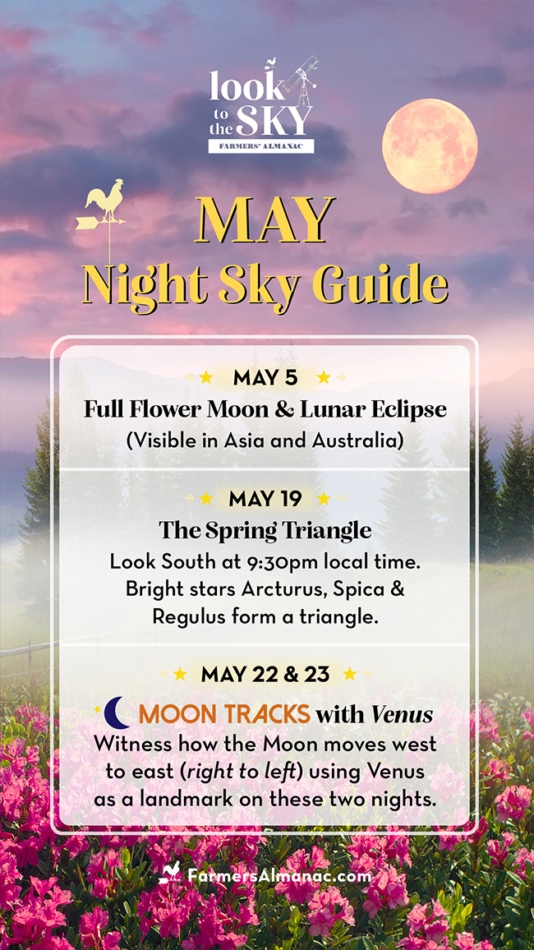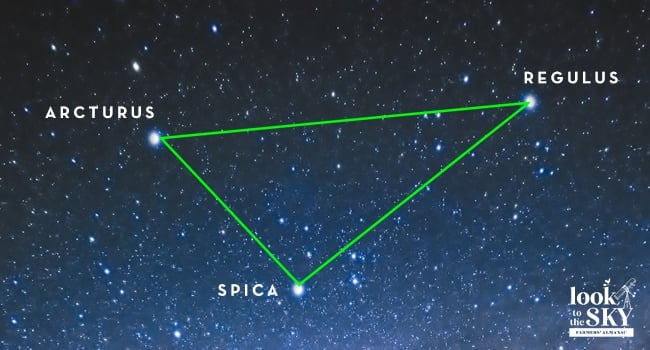May’s night sky brings the Full Flower Moon, a lunar eclipse, and opportunities to witness some of the brightest stars in the sky. Look southeast for Arcturus in “The Spring Triangle” and west for Venus shining after sunset, especially towards the end of the month when she will be accompanied by the crescent Moon. Learn everything you need to know with our calendar of sky events here.
Do you have your “star binoculars” yet? How about a telescope? They are not required, but many sights are best seen with optical enhancement! Look for the telescope emoji – ? – as a quick reference for sky events where we particularly recommend them.
Bookmark this page now (Press command+D on your keyboard) so you can easily refer to it over the next few weeks. If you’re interested in locating particular planets in the sky throughout the year, take a look at our visible planets guide.

May Night Sky Guide
May 1 – Mercury And Venus
Mercury is at inferior conjunction with the Sun on this day. In the days that follow, it will become a morning star (having previously been visible in the evening sky).
In the early evening, look west for Venus between the horns of the Bull: Taurus (The tips of the horns are called Beta Tauri and Zeta Tauri.) How soon after sunset (or even before sunset) can you spot Venus in the deepening blue sky? Blazing at magnitude -4.1, this planet seems to swell enormously as twilight fades, and remains shining for about 90 minutes after twilight’s end before disappearing over the western horizon line, seemingly chasing after the Sun.
May 5 – Full Flower Moon And Lunar Eclipse
The Full Flower Moon reaches peak illumination at 1:34 p.m. EDT.
New! – Get your free Flower Moon Horoscope.
This full Moon will also undergo a “penumbral” lunar eclipse, which means that only part of the Earth’s shadow will cover it. This eclipse will not be visible from the United States because it will take place during the daytime, but other portions of the world will be able to see it: Eastern Africa and Madagascar, central and eastern Asia, Indonesia, Australia and southern New Zealand.
Learn the Flower Moon’s alternate names — like “Frog Moon” — and more!
May 6 – Eta Aquarid Meteor Shower
This year is not a good year to see the Eta Aquarid Meteor Shower because it will reach its peak within one day of the full Moon. Therefore most of the meteors will be squelched by bright moonlight.
May 9 – Venus And Star Cluster M35
? Venus passes in less than two degrees from the big open star cluster M35 (at the feet of the constellation Gemini).
May 12 – Last Quarter Moon
The last quarter Moon occurs at 10:28 a.m. EDT.
May 13 – The Moon With Saturn
Look southeast at dawn’s first gleaming to see the Moon rising with Saturn (five degrees apart — the width of three fingertips). If you are lucky enough to have an unobstructed view of the southeast horizon, you may be able to also spot the 1st-magnitude star Fomalhaut twinkling twenty degrees beneath (and a bit to the right). Although Saturn brightens slightly (to magnitude +1.0) during May, its rings will continue to narrow (as we have mentioned in previous Night Sky Guides).
May 16 – Procyon, Venus, And Capella
Look west at approximately 9 p.m. local time to see three of the brightest celestial bodies shining in a row. Left to right, these are: Procyon (the sixth brightest star), Venus (the brightest celestial object, besides the Sun), and Capella (the fourth brightest star).
This is a great opportunity to see two of the brightest stars. See our list of the 10 brightest stars – Tap here!
May 17 – “Scope It Out” – Jupiter And The Crescent Moon
? Look east before sunrise to catch Jupiter hanging to the left of the crescent Moon. If you are on the West Coast, Jupiter will hide behind the Moon as they both rise. This phenomenon is called a “lunar occultation.” After a few moments, Jupiter will appear to emerge from the dark side of the Moon. In Los Angeles, Jupiter will come into view at 5:14 a.m. PDT; San Francisco, 5:19 a.m; Seattle, 5:30 a.m. Have a telescope? Watch for two of Jupiter’s largest Moons: Ganymede and Callisto!
May 19 – New Moon “Star View” – The Spring Triangle
The new Moon occurs at 11:53 a.m. EDT. New Moons are a great times for stargazing because the Moon is absent from the sky and the stars seem to shine brighter than usual. On this night, we recommend looking for “The Spring Triangle.” (The Spring Triangle will be visible all throughout spring and into summer.)
The Spring Triangle is comprised of three bright stars: Arcturus (in Boötes), Spica (in Virgo), and Regulus (in Leo). Look south at approximately 9:30 p.m. to locate Spica. Then look to the left (southeast) and to the right (southwest) to locate the ones on either side.

The constellation Virgo hangs within The Spring Triangle. In almost every culture Virgo symbolizes a female figure, often carrying an ear of corn or sheaf of wheat (represented by Spica).
Virgo’s head is to the west, marked by the faint star, Zavijava. Her feet are marked by Mu and an unlettered star called “109.” Her right arm extended from Porrima to Vindamiatrix (Latin for “grape gatherer”). In her right hand (on our left) she is usually seen to carry a staff. It’s easier to see Vindamiatrix as her head, with a shawl draped over her shoulders, Porrima and Zaniah. R.H. Allen an authority on star nomenclature notes the antiquity of this figure: “She is the oldest purely allegorical representation of innocence and virtue.”
May 21 – Venus And Gemini
About an hour after sunset, look for Venus in the western sky. The bright planet hangs equidistant below the twin stars of Gemini, Pollux and Castor, forming a tall “V” with them. Make a note to look again at the end of the month when they will almost form a horizontal line.
May 22+23 – “Moon Tracks” with Venus
Did you know that the Moon moves right to left (west to east) over the course of the month? (This is the opposite direction that it appears to move on any given night.) Get a glimpse of its true motion as it orbits the Earth by using Venus as a landmark on these two nights! (Venus is much slower moving than the Moon, so it makes a great reference point.)
On the first night, May 22, the waxing crescent Moon will be positioned to the lower right of Venus. The following night, May 23, it will be positioned to the upper left.
If either of these two nights happens to be cloudy or foggy, rest assured there will be many other chances to track the Moon in the future. Stick with us!
May 24 – The Moon And Mars
Keep your eyes peeled for the Moon this evening. The reddish glowing “star” to the lower left is the planet Mars. Off to the right, you will see Venus and Gemini (as noted previously in this guide).
May 27 – First Quarter Moon
The first quarter Moon occurs at 11:22 a.m. EDT.
May 29 – Mercury
? Look towards the eastern horizon approximately one hour before sunrise to see Mercury. We recommend using binoculars as it will be difficult to see the +0.6 magnitude planet. Typically, Mercury is best seen when it is at greatest elongation from the Sun — as it is today — but its proximity to the Sun makes it hard to spot.
Looking ahead to June, Mercury may become visible to the unaided eye …
May 29+30 – Manhattanhenge
Do you live in New York City (or will you be visiting at the end of May)? If so, feast your eyes on “Manhattanhenge,” when the setting Sun aligns with east-west streets in Manhattan to create a dazzling display. Learn more!
May 29 – A Hero In The Night Sky On Memorial Day
On Memorial Day night, after you have honored military heroes who have fallen, look east to see Hercules rising on the horizon. According to ancient mythology, Hercules was a great hero who overcame many trials in his lifetime and was rewarded for his efforts by being placed among the stars. Learn more about Hercules.
Degrees Explained
Did you know that you can use the size of your hand to judge distances between objects in space? See our illustration below:

Magnitudes Explained
Magnitudes refer to the brightness of an object in space. The lower the number, the more dazzling it is. Bright stars are 1 or 0 magnitude. Fainter ones are 5 or 6. Super bright stars are in negative numbers. For instance, Sirius is magnitude -1.4. (For reference, the full Moon is -12.7 and the Sun is -26.7.)
Footnote
All times and positions are listed in Eastern Standard Time, 40 degrees north of the equator.
If the time is designated as “local,” it is true for every time zone (no adding or subtracting hours is necessary). Any mentions of sunset, midnight, and sunrise are true for every time zone in the United States.
Join The Discussion!
What sky event are you looking forward to in May’s night sky?
Share your excitement with your community here in the comments below!

Mes a mes siempre algo k aprender.
Gracias fuente creadora.